There are six types of tuna often used for sushi toppings: Pacific bluefin tuna, Atlantic bluefin tuna, Southern bluefin tuna, Bigeye Tuna, Yellowfin Tuna, and Albacore. Obviously, the taste differs depending on the type.
Let’s take a look at the detailed characteristics of these six types of tuna
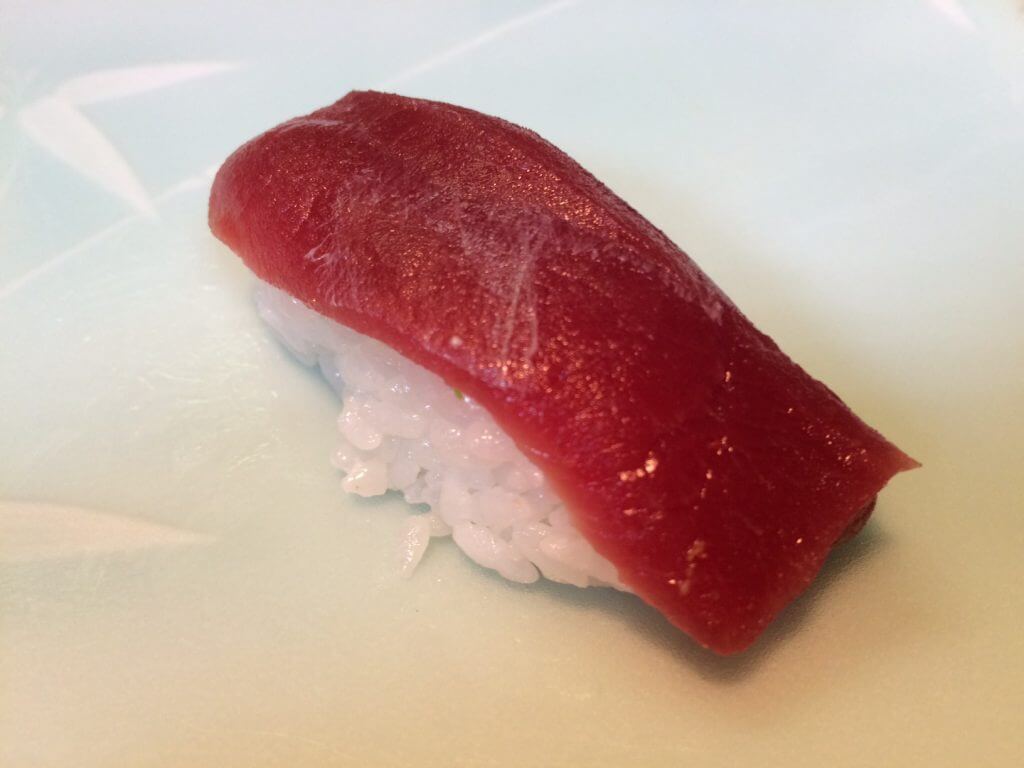 Pacific bluefin tuna (Taiheiyou kuro maguro)
Pacific bluefin tuna (Taiheiyou kuro maguro)
Scientific name: Thunnus orientalis (Temminck and Schlegel,1844)
Japanese: 黒鮪 (kuro-maguro). This is the king of tuna, and is also known a shibi or honmaguro. At its largest, it is 3m long and weighs up to 400kg. It represents 1% of all-natural tuna resources. It is really the jewel of the ocean. Inshore raw tuna is fresh and tastes amazing. They used to say that there was no substitute for it, but now that it is possible to quick-freeze to 60°C below zero, it can be brought to Japan from all over the world. The wholesale price of pacific bluefin tuna (fresh) at Toyosu Market is 80 to 600 US dollars per kilogram depending on the part.
Atlantic bluefin tuna (Taiseiyou kuro maguro)
Scientific name: Thunnus thynnus (Linnaeus, 1758)
At the markets, “Kuro maguro” is a mix of two types of fish. One is the Atlantic (or Northern) bluefin tuna, which takes a long migration route from the east coast of North America to the Black Sea and spawns around the Mediterranean Sea. The other is the Pacific Bluefin Tuna, which migrates across the Pacific Ocean from the seas around Japan to the west coast of North America, and spawns in Japanese territorial waters. These two types are subspecies (some believe they are actually different species), they look almost exactly the same, both have lifespans of 30 years and grow to nearly 400 grams at full size. The differences are really only the shape of the abdominal cavity when dissected.
Atlantic (or Northern) bluefin tuna from New York, Boston and Canada are ranked higher, followed by those from Spain, Malta and Croatia, which have slightly inferior meat. In particular, the areas in the ocean where Irish Atlantic (or Northern) bluefin tuna is caught in the northernmost of the cold regions so the water temperatures are very cold. Therefore, the meat of the fish body firms and grows more fat to protect the internal organs from the low water temperatures.
Generally, Atlantic bluefin tuna from the Northern Atlantic has both fat and umami, and normally the price is comparable to wild Pacific Bluefin Tuna in neighboring waters. Toyosu Market does not distinguish between the two types of Kuro maguro.
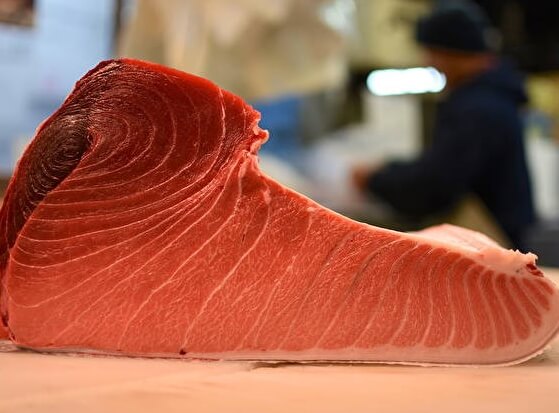 Raw tuna is inshore tuna, jumbo tuna, etc.
Raw tuna is inshore tuna, jumbo tuna, etc.
Tuna caught in Japan’s seas change locale depending on the season, and it is brought to the market raw. The main locations are Uchiura Bay (also Funkawan), Toi, Oma, Matsumae, Shiogama, Sado Island, Iki, Kii-Katsuura, Aburatsu, Okinawa and more. The quality of Pacific bluefin tuna caught in the Tsugaru Strait from Fall to Winter is very good quality and trades at high prices. Further, the Bluefin tuna which is caught in the Atlantic ocean is transported packed in ice and raw is known as “Jumbo tuna.” It is considered to be the next best Tuna after the inshore variety. Jumbo doesn’t mean it’s big. Instead, it means that it is imported on a jumbo jet.
 Those imported to Japan are frozen and come from the Atlantic Ocean or the Mediterranean Sea
Those imported to Japan are frozen and come from the Atlantic Ocean or the Mediterranean Sea
Bluefin tuna from the Atlantic (the US and Canada’s east coast) and the Mediterranean (Spain, Morocco, Italy, etc.) are for the most part frozen. This is not well known, but due to the progress of refrigeration technology, the frozen tuna may be rated higher for taste than raw tuna which is more difficult to manage from a transport logistics perspective.
Most tuna in distribution are fattened
Of course, if it doesn’t get to travel the wide ocean, it doesn’t get as much exercise and the taste degrades. Pacific bluefin tuna you can get at supermarkets and conveyer belt sushi is almost all fattened*.
*Fish fattening is to catch tuna by a fixed net fishing method when they are skinny after egg-laying, and to fatten by feeding wild fish such as sardine and mackerel for three months.
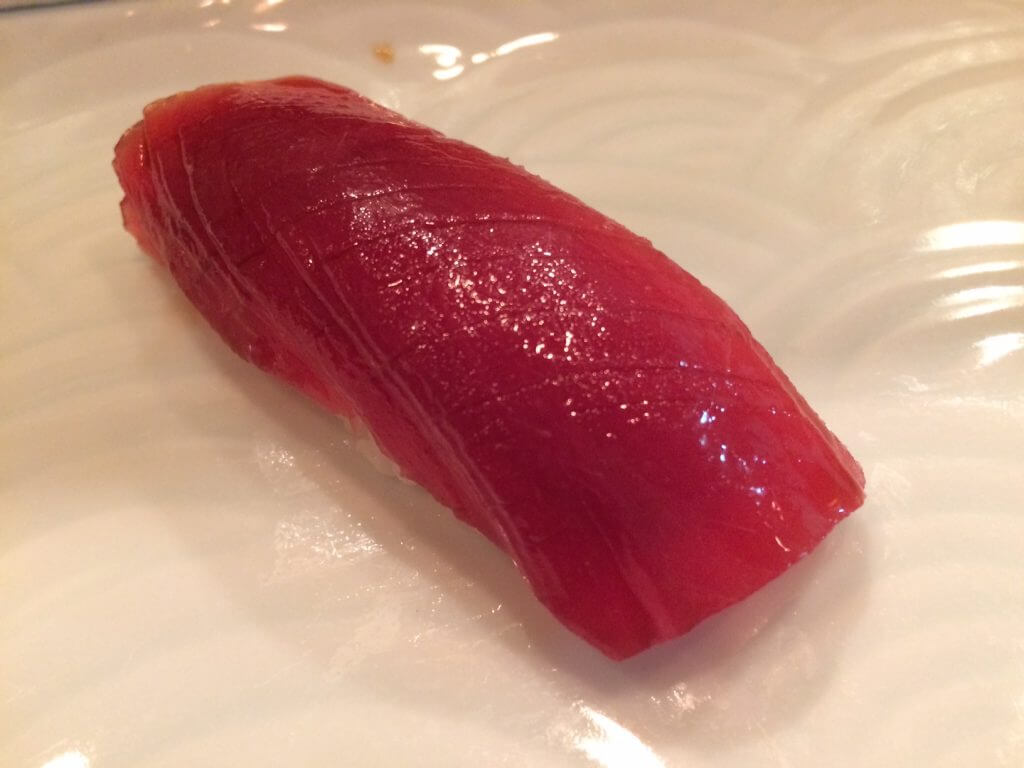
Southern bluefin tuna
Scientific name: Thunnus maccoyii (Castelnau, 1872)
Japanese: 南鮪 (minami-maguro). This type is more often caught in the Indian Ocean so it is known as Indian tuna in Japan. With a body length of 2.4m and a weight of 250kg, it is not as big as the Pacific bluefin tuna. Compared with pacific bluefin tuna, there are more fatty parts. It is the most expensive tuna after Pacific bluefin tuna. The wholesale price of southern bluefin tuna (frozen) at Toyosu Market is 17 to 25 US dollars per kilogram.
In summer the taste of pacific bluefin tuna worsens in Japan, so the southern bluefin tuna, which has opposite seasons of the Pacific Bluefin, becomes the choice tuna. The top-quality tuna are those caught in low-temperature waters with fast currents such as the coast of Cape Town, South Africa, the coast of New Zealand, and Tasmania, Australia. They are normally imported frozen. The fattened southern bluefin tuna of Port Lincoln, Australia is almost entirely exported to Japan.
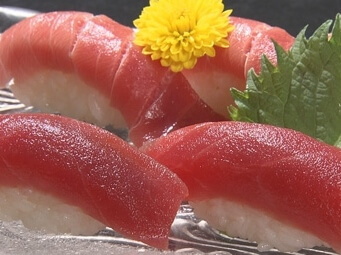
Bigeye Tuna
Scientific name: Thunnus obesus (Lowe, 1839)
Japanese: 目撥鮪 (mebachi-maguro). The Japanese name means big eyes and stocky head and it looks just like that. It is discernable by its thin white stripes that run through its contrasting bright red body. It is widely fished in the tropical and warm waters of the Pacific, Indian, and Atlantic oceans and can reach a total length of 2m. They swim deeper than any other tuna, (100m-150m below the surface) just off the coast. Ships use long fishing lines** to catch them. Once caught, they are processed on the boat and flash frozen. These are mainly used for the sashimi in supermarkets, izakaya-style restaurants and conveyer belt sushi restaurants. Compared with the pacific bluefin tuna, it has the advantage that its color does not generally change and it is often used in deliveries. The wholesale price of bigeye tuna (frozen) at Toyosu Market is 7 to 20 US dollars per kilogram.
**Longline fishing method
To hang a long line (Mikinawa) in the sea, covered with about 3000 fishhooks attached to branch lines (Edanawa), aiming at a path of schooling tuna.
When fishing inshore between April and May, Bigeye tuna gets caught in fixed nets*** of Kyushu and Shikoku, and it is prized as a replacement for Pacific bluefin tuna during seasons where its taste is not its best. Further, those caught from Autumn are higher in fat content and traded at high prices comparable to Pacific bluefin tuna. It has more akami (red meat) compared with Pacific bluefin tuna, but it is sweet as you’d expect from tuna with good balance. It is not widely distributed and it is often consumed locally.
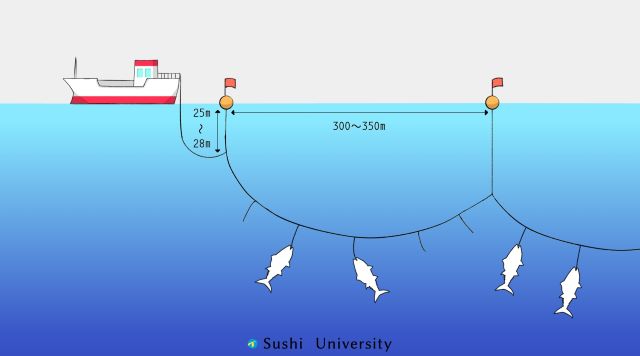
Longline fishing method (延縄漁法)
*** Fixed net fishing method
Tuna have a habit of migrating to the same ocean area at the same time each year. A coastal fishing method called Fixed net fishing consists of placing a net in the sea and wait for a school of tuna. The advantage of this method is to be able to capture the fish alive without causing any injury or damage.
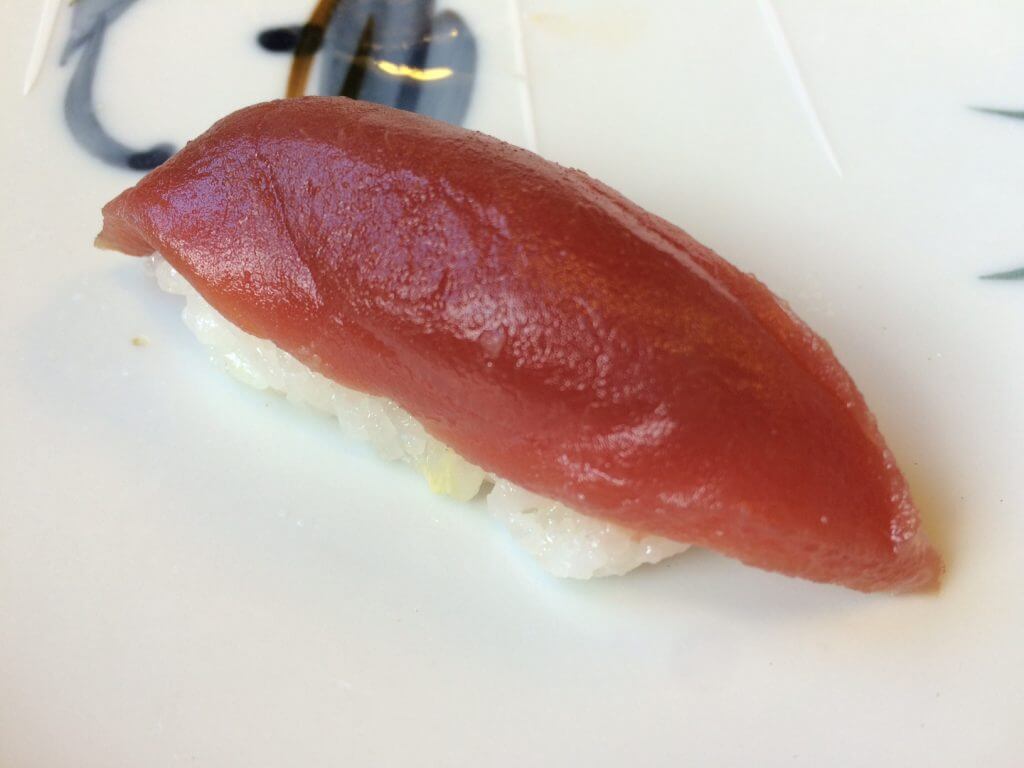
Yellowfin Tuna
Scientific name: Thunnus albacares (Bonnaterre, 1788)
Japanese: 黄肌鮪 (Kihada). It is named for its yellow skin. It is approximately 1.5 m in length. It weighs approximately 50-100 kg. Those caught inshore in Japan are cooled on ice and brought to the fishing port raw. Those caught farther away are frozen before being brought ashore. This is the most common tuna catch and it is essential for ingredients such as canned tuna. It does not have any part that could be considered fatty tuna, and it is low on fat in general. Because of its fresh and high-quality taste, you can never get tired of eating it. In Hawaii, it is also a popular topping called Ahi. Further, its light and refreshing taste is preferred in Osaka where, if you ask for tuna, you’ll get yellowfin. The wholesale price of yellowfin tuna (frozen) at Toyosu Market is 6 to 18 US dollars per kilogram.
Albacore
Scientific name: Thunnus alalunga (Bonnaterre, 1788)
Japanese: 鬢長鮪. Also called “binnaga-maguro,” or “bincho-maguro.” This is the smallest of the tuna with a length of about 1.2m and a weight of 40kg. Albacore (Binnaga maguro) is found from temperate to tropic regions all over the world and mainly southward of the Tohoku regions of Japan. They are sometimes found in the southern part of Hokkaido, but it is rare to see them in the Japan Sea. The fishing sites in the Pacific Ocean are the southeastern seas of Japan, the coast of North America and the open seas of the South Pacific Ocean. Around Japan, the long line fishing method and ipponzuri**** are mainly used. The color of the meat is a soft pink and it is soft, so it wasn’t considered to be suitable for sashimi, but lately, more fatty meat is used for both sashimi and sushi toppings. The source of canned tuna is called white tuna and it is of superior quality to the light canned tuna made from kihada maguro. Canned tuna in oil is used for salad and sandwiches. Also, since the meat doesn’t harden when heated, it is preferred for steak and teriyaki. The wholesale price of albacore tuna (frozen) at Toyosu Market is 3.5 to 4.0 US dollars per kilogram.
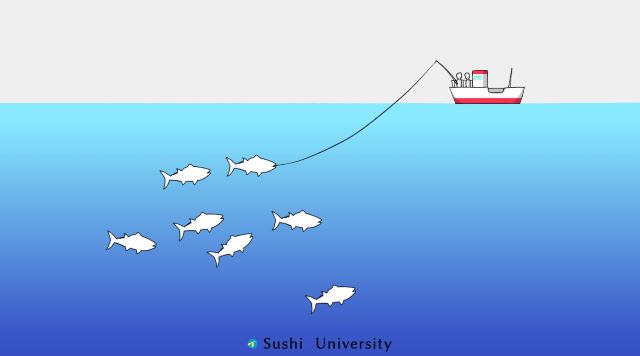
Ipponzuri (一本釣り)
****Ipponzuri (catching fish with fishing poles)
This method has the longest history and uses a pole of 4 – 6 meters to fish from a boat. Using a machine that winds up lines automatically and also using human hands, pulls up tuna that weighs more than 100kg and lastly catch it by piercing gills with a harpoon.
<Nutrition and Effects of Albacore>
Albacore has the highest protein content among types of tuna and a special feature is the low-calorie count of 117 calories per 100 grams. Besides proteins, Albacore tuna is also rich in vitamins like niacin, B6 and B12, and minerals such as potassium, phosphorus and selenium.
 What is the “bintoro” you see at conveyor belt sushi?
What is the “bintoro” you see at conveyor belt sushi?
Albacore tuna swims close to Japan’s shores from Spring to Summer and because of what it eats (mainly sardines), it has lots of fat and its body turns from pink to white. This is called “bintoro (Sometimes called Shiro maguro or white tuna).” It’s a popular item at conveyor belt sushi. As an aside, the deep-sea fish Escolar is sometimes used as a substitute for Albacore tuna because the taste is similar to toro. You should be careful though, as this fish is known to stimulate bowel activity. Incidentally, this fish is not sold in Japan.
What are akami and toro?
Maguro is categorized as toro or akami, depending on the meat. The meat from the belly side, that envelopes the organs, is called toro. Otoro is fatty meat close to the head and has a lipid content of 25 to 30%. During winter, this increases to nearly 40%. The charm of toro is that it feels like it melts in your mouth almost immediately. Toro is generally taken from “harakami” and “haranaka”, and categorized as otoro and chutoro. However, there are no clear standards to distinguish otoro and chutoro.
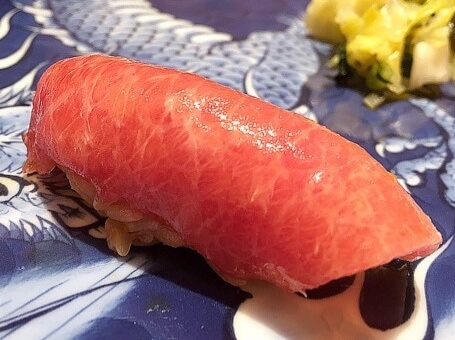 Sunazuri is meat from the bellows with white lines. These lines soften when the meat is matured, so it melts in your mouth. In the shimofuri part of the fish, the fat in the muscle is fine and there are no lines. This is generally otoro. The image on the right is otoro sushi.
Sunazuri is meat from the bellows with white lines. These lines soften when the meat is matured, so it melts in your mouth. In the shimofuri part of the fish, the fat in the muscle is fine and there are no lines. This is generally otoro. The image on the right is otoro sushi.
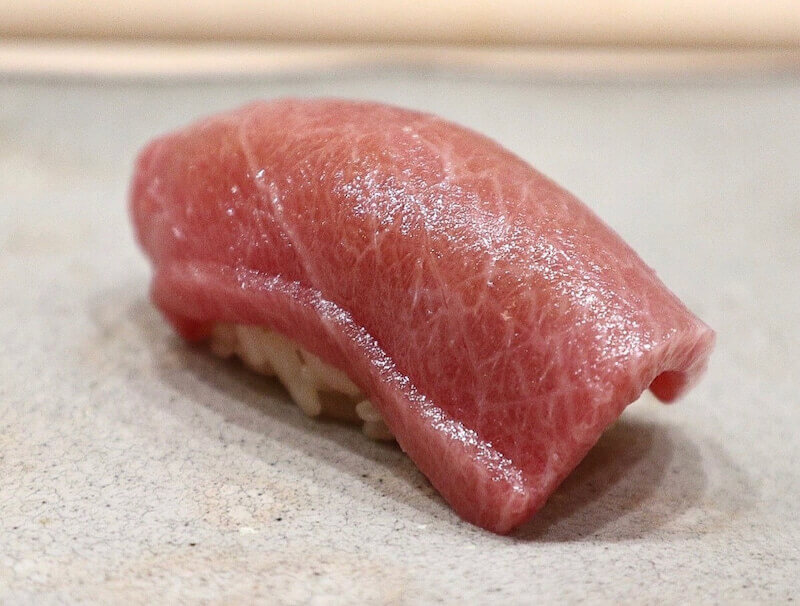 The fat content of chutoro is about 15 to 20%. This is lower than otoro, but it has a smooth texture and it also feels like it melts in your mouth. Chutoro is found on both the belly and the back of tuna’s body, and combines the sweetness of otoro fat and umami of akami. The toro taken from the senaka part is all chutoro. This is called setoro or shotoro. Setoro is the flesh located on the side of the dorsal fins. There are tendons because it is the part that moves a lot, but it got condensed umami from chutoro and akami. Connoisseurs of sushi prefer this portion rather than otoro. However, only a small amount can be taken from each tuna and this makes it so valuable. The image on the right is chutoro sushi.
The fat content of chutoro is about 15 to 20%. This is lower than otoro, but it has a smooth texture and it also feels like it melts in your mouth. Chutoro is found on both the belly and the back of tuna’s body, and combines the sweetness of otoro fat and umami of akami. The toro taken from the senaka part is all chutoro. This is called setoro or shotoro. Setoro is the flesh located on the side of the dorsal fins. There are tendons because it is the part that moves a lot, but it got condensed umami from chutoro and akami. Connoisseurs of sushi prefer this portion rather than otoro. However, only a small amount can be taken from each tuna and this makes it so valuable. The image on the right is chutoro sushi.
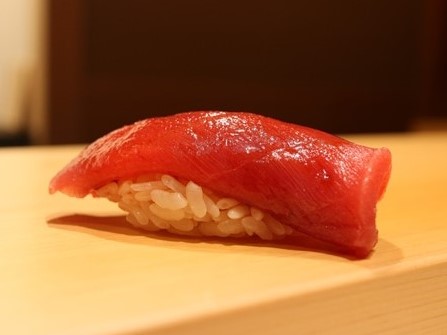 There is a lot of akami on the backside and has less fat content than toro. This part is rich in minerals like iron so you can enjoy the tuna’s natural umami. High-quality akami has a fine texture and melts smoothly in your mouth. Akami located on the back is softer and tastes better compared to the one from the belly. The image on the right is akami sushi.
There is a lot of akami on the backside and has less fat content than toro. This part is rich in minerals like iron so you can enjoy the tuna’s natural umami. High-quality akami has a fine texture and melts smoothly in your mouth. Akami located on the back is softer and tastes better compared to the one from the belly. The image on the right is akami sushi.
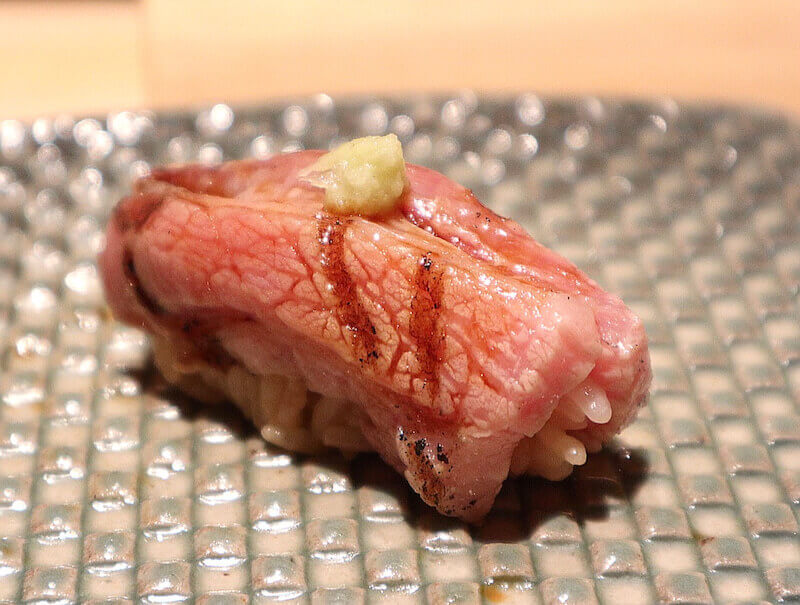 Kama refers to the triangle-shaped portion located from the inside of gills to abdominal fins. There is beautiful marbling otoro above abdominal fins. Otoro within the kama is called kamatoro. Among others, kamatoro contains a lot of DHA and EPA, and has an effect on preventing dementia and adult disease. Of all the tuna body parts, it is the fattiest portion and it adds even more fat in winter. Searing rare cuts like kamatoro and nouten (tuno-toro or hachinomi) drains the fat just a bit and makes it easier to eat. The image on the right is aburi toro sushi.
Kama refers to the triangle-shaped portion located from the inside of gills to abdominal fins. There is beautiful marbling otoro above abdominal fins. Otoro within the kama is called kamatoro. Among others, kamatoro contains a lot of DHA and EPA, and has an effect on preventing dementia and adult disease. Of all the tuna body parts, it is the fattiest portion and it adds even more fat in winter. Searing rare cuts like kamatoro and nouten (tuno-toro or hachinomi) drains the fat just a bit and makes it easier to eat. The image on the right is aburi toro sushi.
The delicious flavor of toro is said to come from the inosinic acid and fat- melting together in your mouth. On the other hand, in akami the inosinic acid overpowers the umami. Therefore, people say that if the akami is good, then the toro will be delicious. Also, maguro (tuna) ties together the umami and amino acid components soy sauce, etc., rapidly improving the taste. Considering the acidity, the fat that melts in your mouth, the umami and fragrance and texture, it’s only natural that people love maguro as a sushi topping.
*Specifically, Pacific bluefin tuna parts are generally cut into 3 backside pieces and 3 belly side pieces for a total of 6 cuts. The parts near the head on both the backside and the belly side is called “kami” which can be loosely translated as “top”, the parts near the tail are called “Shimo”, which is loosely translated as “bottom” and the middle is called “Naka” which means “middle”. Also, the part near the head on the belly side is called “harakami” (hara meaning belly) and the middle part on the backside is called “senaka”, for a total of six specific parts of the fish.
Incidentally, in large tuna (exceeding 150 kg), both the back and belly sides are cut into four to six cuts each. The cuts are called Ichiban (first), Niban (second), etc., starting with the piece closest to the head. The closer the belly piece is to the head, the higher quality it is considered to be. Colloquially this is called “Harakami-Ichiban” (harakami first). Sequentially it is called “Harakami-Niban” (second) and “Harakami-Sanban” (third). The highest grade tuna Harakami-Ichiban goes for 500 to 1000 US dollars per kilogram.
The history of how toro sushi became a superstar
There is a book written toward the end of the Edo period that ranks tuna. According to that ranking, Kihada Maguro (Yellowfin tuna) ranks number one. Makajiki (Striped marlin) ranks in the middle. Kuro Maguro (Bluefin tuna) is ranked at the bottom.
At that time, tuna was caught in what we now call Nagasaki and Miyagi prefectures, which were both far from Edo. That means by the time the tuna arrived in Edo, much of the freshness was lost. It’s no wonder those fish were not delicious and unpopular. Furthermore, at that time only akami was consumed. The reason was, with the lack of refrigeration technology, the fatty parts of the fish were damaged easily so it was unrealistic to preserve those parts and transport them long distances.
Nowadays the most popular part of tuna is the fatty toro part. However, prior to WWII, toro was treated as ara (the name of the useless leftovers of the fish). Certainly in the 1920s Bluefin tuna was treated as “Gezakana” (a cheap and low-grade fish).
This was because even if the tuna was marinated in soy sauce, the salt content of the sauce didn’t permeate the fish so the quality deteriorated easily and the flavor of the fat was strong, so it didn’t suit the taste of the residents of Edo at the time. However, in the 1960s refrigeration and transportation technologies progressed, and imported tuna became a real industry, giving people access to fresh tuna at reasonable prices. In addition, the diet of the Japanese people changed drastically and the country started to appreciate food with high-fat content. This catapulted toro sushi into stardom. After that, toro sushi became synonymous with high-quality sushi all over the world.
Etymology of Toro
Whenever people talk about Toro of Tuna, they always say that even in the case of Sushi, people used to eat Akami exclusively, and Toro became popular only relatively recently.
Tuna itself seems to have been eaten since the Jomon period (14.000 BC ~), but it was not until the late Edo period (1804-1818) that common people began to eat Tuna fatty meat. At that time, Toro was a free part of the fish that could not be served to customers. Edo people disliked greasy food, and it may have been a factor that preservation was not effective. Nevertheless, they devised a way to eat it, and Negima-nabe, a dish in which leeks and toro are simmered in soy sauce, was born. Before World War II, however, Toro was not welcome for sushi, and until around the early Taisho period, there was no such topping called Toro.
Incidentally, Toro got its name from the first sushi restaurant established in 1879 called Yoshino Sushi. Until then, the fatty meat was called things like “abu”, but the Mitsui Bussan employees, who were regular customers at Yoshino Sushi, were discussing how nothing called “abu” could sell and they should change the name. They came up with the name “toro” for the simple reason that the fatty part feels soft and supple in your mouth and the word “toro” describes this sensation. Apparently, they even got as far as deciding on the name “otoro” for parts with the most because “o” means “a lot”, and “chutoro” for parts with a medium level of fat because “chu” means “medium” in Japanese.
There may be other theories as to the origin of the word Toro, but the etymology is probably something like this.
 What is Fresh tuna?
What is Fresh tuna?
Let’s review the definition of “fresh tuna”. You may think it is trivial, but there is a deep connection between why tuna is so delicious and why it is so expensive as a sushi topping. The tuna we’re referring to here is based on the expensive bluefin tuna.
“Fresh tuna” doesn’t mean tuna that has not been cooked, it means tuna that has never been frozen. In other words, fresh tuna is the antonym of frozen tuna, and fresh tuna is never frozen (defined as below -18°C) from the time it is caught by the fisherman to the time it enters the consumer’s mouth.
So, why do both raw distribution and frozen distribution methods exist?
The reason for this is that there is a big difference in where the fish is caught. Generally, fresh tuna is caught in the seas around Japan and the boats return to port within hours after the catch. Frozen tuna, on the other hand, is caught by deep‐sea fishing, for which the boats may not return to port for days and usually weeks. This need led to the invention of the onboard rapid freezing method.
Next, considering the effects on the taste, there is an advantage to frozen tuna. Tuna stored at -60°C is said to keep for two years. Meanwhile, handling fresh tuna is extremely difficult. At the distribution stage, the idea is to maintain the fish meat at a temperature where it won’t freeze, but there are often cases in which the meat is exposed to external temperatures, dropping the quality.
Now, what is the overwhelming difference when comparing fresh tuna and frozen tuna? That is the aromatic flavor. This is true not only for fish but for vegetables and meat as well.
Once the raw cells are frozen, generally those cells will burst due to the ice made from the internal moisture freezing. The moisture inside the food becomes ice crystals, and over time the freeze concentration grows, destroying the cellular tissue. Then, when the frozen food is thawed, the ice in the cells melts, becomes water, and drains out of the damaged cells (this is called “drip”). The food, with softened tissue due to losing the moisture, becomes soft in an unpleasant way. Also, the food’s original umami and nutrition are included in the drip, meaning it loses a great deal of the aromatic flavor. If it is stored frozen for a long time, the moisture in the food will come out, the fat will oxidize and the texture and aromatic flavor will both decline.
The reason that sushi chefs at expensive restaurants insist on using fresh tuna (which is many times more expensive than fresh tuna) is that they desperately want to maintain the aromatic flavor. The techniques required of sushi chefs demand that the subtle, aromatic flavor harbored in the sushi topping is not destroyed.
If you find yourself on a trip to Japan, try nigiri sushi made from fresh tuna. Just forget about the price and ascend to the heaven that is the flavor of fresh sushi.
Do pregnant women need to worry about residual mercury in tuna?
Methylmercury, which is harmful to living things, originally exists in the sea, but In 2001, the U.S. FDA published a guide related to residual mercury in fish and announced a warning regarding fish intake. According to this guide, those who are pregnant or may be pregnant should not intake large fish that contain relatively high concentrations of methylmercury such as shark, swordfish and kinmedai, and for small fish, the recommended limit is 12 ounces (340 g) per week. Based on this, in Japan, the Ministry of Labour, Health and Welfare announced the “Precautions regarding intake of seafood with mercury,” in 2003. After that in 2004, the WHO and FAO joint committee reviewed the concentration of residual methylmercury harmful to humans in seafood. Since Europe and America made their recommendations based on these standards, the MLHW announced their review in 2005.
This announcement stipulated the amount and frequency of species with relatively high mercury content allowed for consumption when pregnant based on the results of testing 385 species in Japan and 165 species overseas.
So how much tuna is safe to consume while pregnant?
The amount considered safe to eat while pregnant is stipulated at 80 g per serving, and Bluefin tuna (Kuro maguro) and Bigeye tuna (Mebachi maguro) can be consumed once a week, while Southern Bluefin tuna (Minami maguro) is safe to eat twice a week. Yellowfin tuna (Kihada maguro), Albacore (Binnaga maguro), Young maguro (Meji maguro) and canned tuna do not need to be restricted and no standards were set for these.
Incidentally, the serving size of tuna differs depending on the way it is eaten and the average amount consumed as sashimi is 50 to 60 g. One piece of maguro sushi is generally 10 to 15 g. One Tekkamaki (tuna sushi rolls, cut into six pieces) generally contains 42 g of tuna. One Tekka-don (tuna sashimi bowl) generally contains 180 g of tuna. Except for Tekka-don, which contains 100 g, most tuna dishes don’t exceed 80 g.
For Japanese people, who consume a high amount of seafood on a regular basis, these announcements caused a commotion and directly after the precautions were published, kinmedai prices dropped dramatically, and there were fishing boats that had to suspend operations. However, these precautions are only intended for pregnant women, with consideration for fetuses that are vulnerable to methylmercury. Furthermore, there have never been reports of health hazards for the daily consumption of seafood in the world, so it is probably sufficient to consider these announcements to be preventive guidelines.
Maguro Nutrition and Effects
Let’s look at the nutrients contained in maguro meat, divided into Akami, Toro, Chiai, Kama, and Medama. As you might expect, the amount of nutrients is affected by the type of tuna. Otoro from Kuro maguro (Bluefin tuna) contains more fatty acids than eel and the most DHA and EPA of all the sushi toppings. Compared to other types of tuna, Kihada (Yellowfin tuna) has a high iron and vitamin B12 content. Bincho (Albacore tuna) has a high niacin content. Minami maguro (Southern bluefin) tuna is characterized by its high vitamin B6 content.
Akami (Red-colored meat)
Maguro akami is on the dorsal side and is known as a healthy food. This is because, compared to fatty toro, it has only about one-third of the calories and is rich in high-quality protein. Compared to other foods, it has more protein per 100g than beef or pork. In modern times, many people’s diets are too heavy on rice and wheat, and they may not be getting enough protein. If you actively include akami in your diet, you can increase your protein intake efficiently.
The amount of niacin in akami is more than twice that of salmon. Niacin is also known as the vitamin of the skin because it improves blood circulation and keeps the skin healthy.
It is also high in vitamin B6. Vitamin B6 is an essential nutrient for maintaining the normal functioning of the immune system, promoting the turnover of skin and mucous membranes, and the synthesis of hemoglobin in red blood cells. It is also involved in the metabolism of estrogen and affects regulating hormone balance.
It contains a high amount of magnesium. It has reassuring characteristics such as increasing the formation of bones and teeth, flexibility and resilience, and making them less likely to break. In addition, it suppresses nerve excitation and is essential for controlling the action of calcium and regulating muscle contraction and relaxation.
It also contains a high amount of iron, which is a characteristic of lean fish.
Selenium, which is abundant in Maguro’s Akami, is an essential nutrient for humans and is absorbed when combined with protein. Selenium has strong antioxidant properties that help to remove active oxygen from the body, which can damage cells, so it is expected to have effects such as strengthening the immune system and preventing aging. In addition, it is also characterized by its ability to reduce the toxicity of metals that are harmful to the human body, such as cadmium and mercury. Furthermore, when taken in combination with vitamin E, selenium has a synergistic effect that provides even stronger benefits.
Toro (Fatty tuna)
Toro, which is high in fat, contains nutrients that are beneficial to the human body. Toro is characterized by the fact that it contains more DHA and EPA, which are unsaturated fatty acids, than akami. Unsaturated fatty acids are found in large quantities in fish and plants, and because the body cannot synthesize them, they need to be consumed. And because the amount of DHA and EPA in the human body decreases with age, older people need to eat foods that contain these.
DHA is said to have the effect of activating brain cells and improving the transmission of information, so it is hoped that it will have a positive effect on learning ability and the improvement of dementia. It is a nutrient that you should actively take from the stage of being a fetus or infant to being an elderly person. EPA has the effect of reducing cholesterol and neutral fat in the blood and improving blood flow and is effective in preventing arteriosclerosis and high blood pressure. In addition, these fatty acids also have the effect of preventing lifestyle-related diseases and lowering the risk of blood clots.
Furthermore, toro is also rich in vitamins, and in particular, it is characterized by its high content of fat-soluble vitamins A, D, and E. Vitamin A is said to inhibit cancer-promoting factors. Vitamin D helps the body absorb calcium. Vitamin E improves blood circulation.
Vitamins D and E are more concentrated in the fatty part of tuna, or toro, than akami. While toro is a healthy food, it is important to be careful. Nearly 30% of toro (27.5g per 100g of edible portion) is fat, which is about 20 times the amount of fat in akami (1.4g). It is a cause of obesity, so be careful not to eat too much.
Chiai (Dark red meat)
Chiai is a part of the muscle that is densely packed with cells called red muscle fibers. Like akami, it is rich in nutrients, so it is a good idea to cook it and eat it actively. The nutrients that are abundant in chiai include taurine, iron, and vitamin E.
Taurine has the effect of improving liver function, and there is also a lot of attention being paid to its effect of promoting the metabolism of cholesterol. Iron and myoglobin are expected to have an effect in preventing anemia. For women, many people tend to be anemic, so it is recommended that you be conscious of taking in iron. Vitamin E is an ingredient that is effective in improving stiff shoulders and lower back pain, as well as in creating beautiful skin. The ingredient called anserine is effective in improving fatigue, lowering uric acid levels, and preventing gout.
Kama (Meat around the gill)
Kama is a rare part of the tuna, with only two pieces taken from each fish. Kamatoro part is particularly fatty. It has a smooth, melt-in-the-mouth texture that rivals that of Otoro. It is rich in nutrients such as EPA, DHA, vitamins A, D, and E.
Medama (Eyeball)
Medama tends to be disliked because of its appearance, but the gelatinous texture of tuna eyeballs is rich in umami so they can be eaten deliciously. In terms of nutrition, it is rich in collagen, DHA, EPA, vitamin B1, etc., and can be said to be a part of the body with high nutritional value.
Types of tuna around the world
Here, tuna are classified biologically. In some cases, species that are not real tuna are referred to as minor tuna. In other cases, species that look similar to tuna are also referred to as tuna. Both of these are incorrect.
1. True tuna species
The “true” tunas are those that belong to the genus Thunnus. Until recently, it was thought that there were seven Thunnus species and that Atlantic bluefin tuna and Pacific bluefin tuna were subspecies of a single species. There are now eight species.
The genus Thunnus is further classified into two subgenera: Thunnus (the bluefin group), and Neothunnus (the yellowfin group).
The bluefin group consists of five species: Pacific bluefin tuna (Taiheiyou kuromaguro), Atlantic bluefin tuna (Taiseiyou kuromaguro), Bigeye tuna (Mebachi maguro), Southern Bluefin tuna (Minami maguro), and Albacore (Binnaga maguro). These have already been explained in detail.
The yellowfin group consists of three species: yellowfin tuna (Kihada maguro), blackfin tuna (Taiseiyou maguro), and longtail tuna (Koshinaga maguro). For more information on blackfin tuna and longtail tuna, please see below.
Blackfin tuna (Taiseiyou maguro)
Longtail tuna (Koshinaga maguro)
Learn more
2. Other species
It calls itself tuna, but it is not a tuna species. The following fish resemble tuna. If the taxon is expanded to include the order Thunnini, Bonito (Katsuo), Bullet tuna (Marusouda), Frigate tuna (Hirasouda) and Black skipjack (Suma)
are also considered to be part of the tuna family.
2-1 Little tunny (Taiseiyou Yaito)
The scientific name is Euthynnus alletteratus (Rafinesque, 1810).
Little tunny can be found in the Atlantic Ocean and the Mediterranean and Black seas; in the western Atlantic, it ranges from Brazil to the New England states. It is a pelagic fish that can be found regularly in both offshore and inshore waters and it is classified as a highly migratory species. It is readily identified by the wavy lines along their upper back, behind the dorsal, and the spots between the pectoral and ventral fins. They form and feed in tight schools, often churning the surface as they gorge on baitfish.
Because of its strong “fishy” taste and the considerable effort required to prepare it, the little tunny is considered by many to be a trash fish and is not commonly eaten. However, it is sought after as a sport fish due to its line-stripping 40 mph runs and hard fighting ability when hooked.
2-2 Black skipjack tuna (-)
The scientific name is Euthynnus lineatus Kishinouye, 1920. This species has not been imported to Japan. There is no Japanese name for it.
This species is one of the few tunas limited to the eastern Pacific, found in waters off California to Peru. The black skippy can be identified by the four or five broad, straight stripes that extend horizontally along its back. A hard-hitting, fast-moving predator, smaller skipjack are popular among anglers for live bait for billfish and large yellowfin. The strong dark-red flesh is not appealing to most fishermen.
2-3 Mackerel tuna (-)
The scientific name is Euthynnus affinis (Cantor, 1849). This species has not been imported to Japan. There is no Japanese name for it.
While often being seen as an undesirable fish like others in its genus due to its strong taste and dark red meat, it is commonly eaten in Hawaiian and Oceanic cultures, as well as being used in sashimi. The kawakawa is also caught in large amounts in the Indo-Pacific region and is canned and sold frozen for human consumption. It is also commonly used for pet food. Due to it being a reef-frequenting species, there is a possibility of ciguatera poisoning.
To distinguish from the closely related black skipjack, also of the Pacific Ocean, the kawakawa has more broken stripes instead of straight stripes spanning the side of the body on the black skipjack.
2-4 Leaping bonito (-)
The scientific name is Cybiosarda elegans (Whitley, 1935). This species has not been imported to Japan. There is no Japanese name for it.
Since the bonitos and tunas are close relatives, this fish has variously been referred to by such other common names as Australian tuna, striped bonito and Watson’s bonito. It is found in coastal and oceanic waters of northern Australia and southern New Guinea. It can reach 45 cm in length.
2-5 Bonito (Katsuo)
Learn more
2-6 Dogtooth tuna (Iso maguro)
Learn more
2-7 Bullet tuna (Marusouda)
Learn more
2-8 Frigate tuna (Hirasouda)
Learn more
2-9 Slender tuna (Hosokatsuo)
Learn more
2-10 Black skipjack (Suma)
Learn more
Tuna Intermediate Wholesalers
Market’s intermediate wholesalers (Nakaoroshi in Japanese) have the key responsibility of acting as middlemen between the wholesalers and small to medium-sized retailers and restaurants. There are middle wholesalers in fish markets all over the country, but Toyosu Market has the largest number of them.
Their job consists of sourcing the best possible product for their clients at the optimal price, a task that requires not only a highly trained eye for seafood but also a sophisticated understanding of what constitutes a fair price and familiarity with the customer’s preferences and circumstances.
Middlemen mainly receive orders from customers and procure the ordered products by participating in auctions at markets or conducting direct transactions with wholesalers. In addition, many middlemen purchase a certain quantity of products from wholesalers and sell them to buyers visiting the seafood wholesale market. It is recommended that general customers go to Toyosu Market after 8:00 a.m.
Intermediate wholesalers usually have a loyal clientele that relies on them to provide the best possible product to serve in their restaurants or sell at their shops. Some middle wholesalers have more than 1,000 customers. Recently, they have also been exporting to customers in Dubai, Hong Kong, Singapore, etc.
Let’s take a closer look at Tuna Intermediate Wholesalers in Toyosu fish market. However, this information is limited to sushi restaurants.
There are about 200 tuna Intermediate wholesalers in Toyosu, but only a few wholesalers sell only fresh bluefin tuna caught in the waters around Japan throughout the year. This is because it is difficult to determine the quality of raw bluefin tuna, making it a gambling business. Of course, information such as the place of origin, fishing method, and time of capture can be traced, but the quality cannot be known until the tuna is cut up.
Tuna varies greatly from individual to individual, and its quality is subtly affected by factors such as season, sea conditions, weather and water temperature at the time of catch, the fish’s diet, fishing methods, the fisherman’s personality, how it is handled after being caught, and its condition during transportation. It is the expertise of the middlemen to assess this before dissection.
First, they shine a flashlight on the cross-section of the tuna’s tail and carefully examine its belly to check the fat content. Additionally, determining the peak of the fish’s flavor and aging it to enhance the tuna’s taste are also crucial tasks for the middlemen.
In addition, sushi chefs who purchase tuna also have their preferences. Some prioritize texture and tenderness, while others prefer fish with vibrant colors. They discern the unique characteristics of the fish based on the day’s orders and strive to satisfy their customers.
Furthermore, even if they cannot catch tuna for several days, they are obligated to supply tuna, and they end up holding inventory.
For sushi restaurants, tuna intermediate wholesalers are like a lifeline, so they never purchase from them solely based on price. As long as they continue operating, they will continue purchasing from the same tuna intermediate wholesalers.
We will introduce the tuna intermediate wholesalers that famous sushi restaurants source from.
【Fujita Suisan (藤田水産)】
Website: Fujita suisan
Sukiyabashi Jiro
Higashiazabu Amamoto
Sawada
Sushi Aoki
Maru sushi
Sushi Nakamura
Sanosushi
【Yamayuki (やま幸)】
Website: Yamayuki
Ginza Harutaka
Sushi Saito
Sushi Hashimoto
Sushi Arai
Sushi Takamitsu
Mitaka Sushikin
Shimazu
Akita Sushisho
Sushi Kuriyagawa
Satake
Jukuseisushi Yorozu
Sushi Ryusuke
Takumi Shingo
Sushi Masashi
Sushi Masuda
Sushi Ryujiro
Edomachi Sugimoto
Kurosaki
【Ishiji (石司)】
Hatsunezushi
Saeki
Kuwano
Sushi Keita
Sushi Kano
【Hicho (樋長)】
Website: Hicho
Yanaka Matsuzushi
Sushi Inomata (Kojimachi Nihei)
Sushiya Hazime
Kikusushi
Sushi Komari
【Yuasashoten (湯浅商店)】
Nojima
【Daiga suisan(大雅水産)】
Nihonbashikakigaramachi Sugita
【Daizen (大善)】
Teruzushi
【Yuinohana (結乃花)】
This tuna intermediate wholesaler is highly regarded by the next generation of sushi chefs recently. Its business partners are as follows.
Ebisu Endo
Sushi Take
Tokiwa Sushi
Sushi Asahi
Sushi Yuki
Sushi Mizukami
Sushi Yamato
Sushi Ojima
Sushi Takayama
Sushi Kawanaka
Sushi Ino
Measures Against Food Fraud Involving Tuna
Tuna species are difficult to distinguish from one another due to their similar appearance, making it challenging for laypeople to identify them. Additionally, since tuna are large in size, they are often distributed as quartered loins or frozen blocks, further complicating species identification. Recently, stricter regulations imposed by various fisheries management agencies have led to the emergence of tuna laundering, where the species or origin of tuna is falsely labeled to evade regulations.Originally developed for research purposes, DNA-based species identification methods are now also used to monitor and detect tuna laundering and illegal trade.
This method is generally referred to as the PCR method (Polymerase Chain Reaction). In simple terms, muscle fragments are collected from imported frozen tuna blocks or loins, and DNA is extracted from these fragments.The specific part of the DNA is then copied millions to billions of times. This “DNA amplification process” increases the amount of DNA, which was originally only present in trace amounts, to a level sufficient for subsequent analysis. This makes it possible to clearly identify even slight differences between species, thereby reducing the risk of misidentification.
The next step is the RFLP method (Restriction Fragment Length Polymorphism).The DNA amplified by PCR is treated with restriction enzymes, which act as “molecular scissors,” cutting the DNA at specific nucleotide sequences. These cutting patterns vary slightly between species, so the lengths and combinations of DNA fragments act as “species-specific fingerprints,” enabling the identification of the type of tuna. In other words, by visualizing the invisible, minute differences in DNA as differences in cutting patterns, species identification becomes possible.
The cut DNA fragments are finally visualized using electrophoresis. Samples are placed on an agarose gel, and when an electric current is applied, the DNA fragments move at different speeds depending on their size. This difference is made visible by staining, resulting in characteristic band patterns for each species. Through electrophoresis, the “fingerprints” of each species’ DNA fragments become visible, allowing for intuitive identification of the specific tuna species.This method for identifying species of tuna was developed in Japan and is now used not only in Japan but also in Australia and New Zealand.
In terms of determining the origin of tuna, there are clear differences in the appearance patterns of DNA fragments between Pacific and Atlantic bluefin tuna, enabling identification at the individual level.In bigeye tuna, differences exist between the Atlantic and Indian Oceans and the Pacific Ocean, allowing Atlantic-sourced fish to be distinguished from others at the lot level. However, the oceanic differences observed in bluefin and bigeye tuna have not been confirmed in yellowfin, skipjack, or southern bluefin tuna, so origin identification for these three species is currently not possible.
Summary
So what did you think? To put it simply, these are the only types of tuna used for sushi. Pacific bluefin tuna is certainly delicious and it’s the front-runner at the markets. However, the Pacific bluefin tuna is not always the most popular depending on the location, the season, and culture of the area.
However, it makes sense commercially that the processing to preserve the freshness of the high-priced Pacific bluefin tuna and southern bluefin tuna on the ship after being caught is superb and the quality management cannot even be compared with other tuna.
If you want to eat tuna in Japan, you should eat natural Pacific bluefin tuna or southern bluefin tuna. I think once you try it you’ll wonder what you were doing eating the subpar tuna of the past when you experience its deep flavor and the umami of the fat. Just for your reference.
Related Content:
Do you know what kind of Tuna you’re eating at a sushi restaurant?
What is the difference between Fish farming tuna and Fish fattening tuna?
Detailed feature or production area of tuna (Maguro)
The migrating route of Inshore bluefin tuna and fishing place.
Tuna is allowed to rest before it is used.
What are Meji , Chubou and Maguro?
What is the difference between the taste of marbled and lined fatty tuna?
Why is sushi with tuna topping so expensive?
Tuna was not a premium fish during the Edo period.
Have you heard of the more rare parts of the tuna?
We will explain fishing methods that could affect the quality of caught tuna.
Why is Zuke used for lean meat?
What is Dogtooth tuna (Iso maguro)?
What makes good quality Kuromaguro?
What is the thought behind Toro?
What are Komono-ya and Oomono-ya?
Share this article
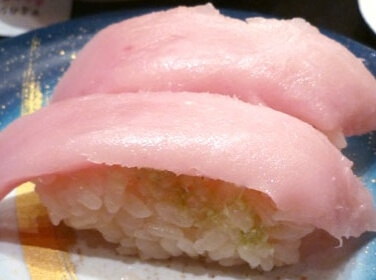 What is the “bintoro” you see at conveyor belt sushi?
What is the “bintoro” you see at conveyor belt sushi?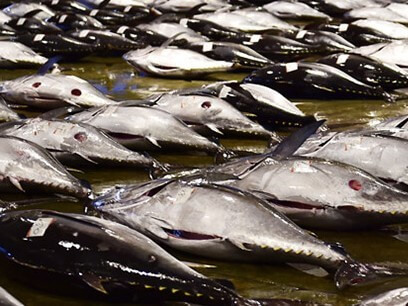 What is Fresh tuna?
What is Fresh tuna?